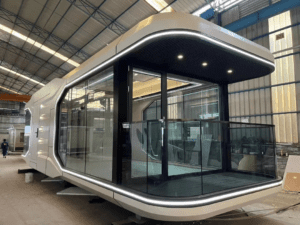
As I explore the evolving landscape of housing solutions, I often come across the term “prefabricated house.” This innovative approach to home construction is gaining traction for its efficiency and versatility. In this article, I’ll delve into what prefabricated houses are, their benefits, and costs, and how they differ from traditional homes, providing a thorough understanding for anyone considering this option.
What is a Prefabricated House?
To put it simply, a prefabricated house is a building that is manufactured off-site in sections or modules and then assembled on-site. This method allows for faster construction times and can often lead to lower costs compared to traditional building methods.But what makes prefabricated homes so appealing? Let’s explore this further.
Why Choose a Prefabricated House?
Prefabricated houses offer several advantages. First, they significantly reduce construction time. Most of the building is done in a controlled factory environment, which minimizes delays caused by weather or on-site issues.Additionally, prefabricated homes can be more cost-effective. With reduced labor costs and shorter construction times, many homeowners find they can save money while still achieving a high-quality home.
What are the Types of Prefabricated Houses?
There are primarily three types of prefabricated homes: modular, panelized, and manufactured homes.
- Modular Homes: These are built-in sections or modules and are transported to the site for assembly. They are often considered equivalent to traditional homes in terms of quality.
- Panelized Homes: This type involves building panels that are erected on-site. They typically require more assembly than modular homes but allow for a great deal of customization.
- Manufactured Homes: Often referred to as mobile homes, these are built entirely in a factory and then moved to a site. They are usually less expensive but have different regulations and standards.
What are the Benefits of Prefabricated Houses?
One of the key benefits of prefabricated houses is sustainability. Many manufacturers use eco-friendly materials and practices, making it easier for us to reduce our carbon footprint.
Another advantage is flexibility. Prefabricated homes come in various designs and sizes, allowing homeowners to customize their space according to their needs.
Furthermore, because the construction process is more streamlined, there’s often less waste generated compared to traditional building methods.
What is the Cost of a Prefabricated House?
The cost of a prefabricated house can vary widely based on factors like size, design, and location. Generally, they can range from $100 to $200 per square foot.
However, it’s crucial to consider additional costs such as land, permits, and site preparation. While the initial price might seem attractive, I always recommend budgeting for these extra expenses.
How Do Prefabricated Houses Compare to Traditional Homes?
When comparing prefabricated homes to traditional ones, there are a few key differences. Prefabricated houses tend to be faster to build and can be more affordable.
On the other hand, traditional homes often allow for more personalized architectural design. Ultimately, the choice depends on individual preferences and circumstances.
Are Prefabricated Houses Safe and Durable?
Absolutely! Prefabricated houses must meet the same building codes and regulations as traditional homes. They are built with high-quality materials and undergo rigorous testing to ensure safety and durability.
Many homeowners find that prefabricated homes are just as sturdy, if not more so, than their traditional counterparts, particularly in areas prone to extreme weather conditions.
What is the Timeline for Building a Prefabricated House?
The timeline for constructing a prefabricated house can vary. However, the entire process—from design to moving in—can often take just a few months.
Once the modules are on-site, assembly typically takes a few weeks, depending on the complexity of the design and local regulations.
Can I Customize a Prefabricated House?
Definitely! One of the significant advantages of prefabricated houses is the ability to customize. From floor plans to finishes, many manufacturers offer various options to tailor the home to your taste.
I encourage potential homeowners to discuss their needs with manufacturers to create a space that truly reflects their lifestyle.
How Do I Get Started with a Prefabricated House?
If you’re considering a prefabricated home, the first step is to research different manufacturers and designs.
I recommend visiting model homes to get a feel for the space and construction quality. It’s also beneficial to consult with experts in the field to ensure you choose the right option for your needs.
Summary and Call to Action
In conclusion, prefabricated houses represent an exciting and efficient alternative to traditional home building. They offer speed, affordability, and customization, making them an attractive option for many.
If you’re interested in exploring prefabricated homes further or have specific questions, feel free to reach out to us. We’re here to help you navigate your options and find the perfect home for you.





